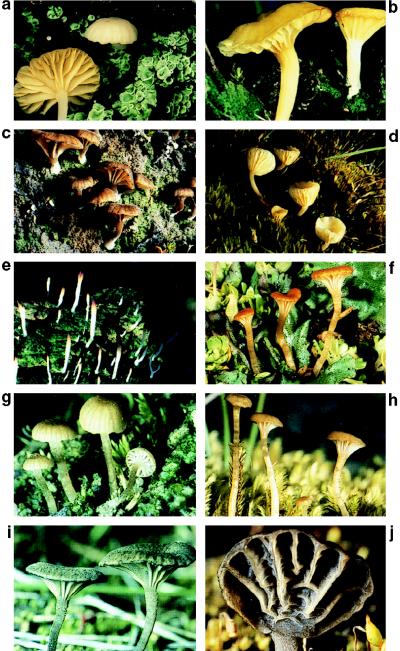Figure 1.
Examples of mutualist (a–g) and nonmutualist fungal species (h–j) included in the present study. Mutualist lichen-forming basidiomycetes associated with the unicellular green alga Coccomyxa (a–e). (a) Omphalina hudsoniana: the green squamule-like structures covering the soil, forming the thallus of this lichen, are comprised of the fungal and algal symbionts (34). The yellow mushrooms are the sexual reproductive structures of the fungal partner of this lichen. (b–d) For these three lichen species, the thallus consists of a green crust covering the substrate (not visible in d). Their thallus is comprised of small globular structures containing the algal symbiont (34). (b) O. luteovitellina (Pilát & Nannf.) M. Lange, (c) O. velutina (Quél.) Quél., (d) O. ericetorum. (e) The thallus of this coral lichen-forming fungus, Multiclavula mucida (Fr.) R. Petersen, is not as differentiated as the one of lichen-forming Omphalina species. It forms the continuous green crust covering the substrate in this picture. (f and g) Mutualist mushroom species associated with thallose liverworts Marchantia polymorpha and Blasia pusilla, respectively: (f) Gerronema marchantiae, (g) Rickenella pseudogrisella. (h–j) Closely related nonmutualist mushroom species: (h) R. mellea (Sing. & Clémenç.) Lam., (i) O. velutipes Orton, (j) Arrhenia auriscalpium (Fr.) Fr. Photographs are by Kolbjørn Mohn Jenssen (a–d and f–j) and Irwin Brodo (e); the former are reproduced with the permission of G. Gulden and K. M. Jenssen (35–37).

